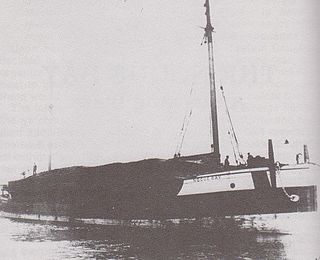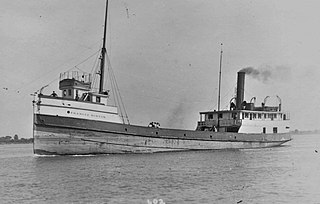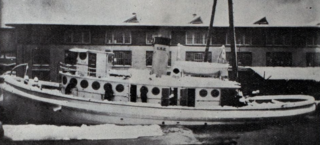
Lake Duluth was a proglacial lake that formed in the Lake Superior drainage basin as the Laurentide Ice Sheet retreated. The oldest existing shorelines were formed after retreat from the Greatlakean advance, sometime around 11,000 years B.P. Lake Duluth formed at the western end of the Lake Superior basin. Lake Duluth overflowed south through outlets in Minnesota and Wisconsin at an elevation of around 331 m above sea level.

SS Comet was a steamship that operated on the Great Lakes. Comet was built in 1857 as a wooden-hulled propeller-driven cargo vessel that was soon adapted to carry passengers. It suffered a series of maritime accidents prior to its final sinking in 1875 causing the loss of ten lives. It became known as the only treasure ship of Lake Superior because she carried 70 tons of Montana silver ore when it sank. The first attempts to salvage its cargo in 1876 and 1938 were unsuccessful. Comet was finally salvaged in the 1980s when the Great Lakes Shipwreck Historical Society illegally removed artifacts from the wreck. The artifacts are now the property of the State of Michigan and are on display as a loan to the Great Lakes Shipwreck Museum. The fate of her silver ore cargo is unknown. Comet's wreck is now protected by the Whitefish Point Underwater Preserve as part of an underwater museum.

SS M.M. Drake was a wooden steam barge that towed consorts loaded with coal and iron ore on the Great Lakes. She came to the rescue of the crews of at least four foundering vessels in her 19-year career only to meet the same fate in her final rescue attempt. Drake sank in 1901 off Vermilion Point after a rescue attempt of her consort Michigan. Her rudder, anchor, and windlass were illegally removed from her wreck site in the 1980s. They are now the property of the State of Michigan. The rudder is on display as a loan to the Great Lakes Shipwreck Museum and the anchor and windlass are on loan for display to Whitefish Township Community Center. The wreck of Drake is protected as part of an underwater museum in the Whitefish Point Underwater Preserve.

MV Paul R. Tregurtha is a Great Lakes-based bulk carrier freighter. She is the current Queen of the Lakes, an unofficial but widely recognized title given to the longest vessel active on the Great Lakes. Launched as MV William J. De Lancey, she was the last of the thirteen "thousand footers" to enter service on the Great Lakes, and was also the last Great Lakes vessel built at the American Ship Building Company yard in Lorain, Ohio. The MV Paul R. Tregurtha is the current flagship for the Interlake Steamship Company.

Noquebay was a wooden schooner barge that sank in Lake Superior in Chequamegon Bay off Stockton Island. The wreck site was added to the National Register of Historic Places in 1992.

The R.G. Stewart was a commercial packet steamer. On June 4, 1899, it caught fire and sank in Lake Superior, off the coast of Michigan Island in Chequamegon Bay. The site of the wreck was added to the National Register of Historic Places in 1991.

T. H. Camp was a wooden tugboat, operated by the Booth Packing Company of Bayfield, Wisconsin. On November 16, 1900, she sank in Lake Superior, between Madeline and Basswood Islands. The site of the wreck was added to the National Register of Historic Places in 2004.

SS Ira H. Owen was a steel-hulled American lake freighter in service between 1887 and 1905. One of the first steel lake freighters, she was built in 1887 in Cleveland, Ohio, by the Globe Iron Works Company, and was built for the Owen Line of Chicago, Illinois. Early in her career, Ira H. Owen carried iron ore from Escanaba, Michigan. In April 1898, Ira H. Owen was chartered by the Baltimore & Ohio Railroad. She was sold to the National Steamship Company of Chicago, on December 30, 1899, for whom she frequently carried coal and grain. Throughout her career, Ira H. Owen was involved in multiple accidents and incidents.

SS Onoko was an iron hulled Great Lakes freighter. She was launched in 1882 in Cleveland, Ohio as hull number #4, and sank on September 14, 1915 in Lake Superior near Knife River, Minnesota. Onoko is thought to be the prototype for every single steel hulled Great Lakes Bulk carrier that ever sailed. These vessels made possible the cheap transport of bulk cargoes such as iron ore, coal and limestone. Her wreckage still remains on the bottom of Lake Superior and was listed on the National Register of Historic Places in 1992.

Antelope was a Great Lakes steamship that later was converted into a schooner barge) and sank in Lake Superior near the Apostle Islands in 1897.

The Amboy was a wooden schooner barge that sank along with her towing steamer, the George Spencer on Lake Superior off the coast of Schroeder, Cook County, Minnesota in the United States. In 1994 the remains of the Amboy were added to the National Register of Historic Places.

SS Selah Chamberlain was a wooden-hulled Great Lakes freighter that sank in Lake Michigan in 1886, 6 miles (10 km) off the coast of Sheboygan, Sheboygan County, Wisconsin, United States after being rammed by the steamer John Pridgeon Jr. with the loss of five lives. On January 7, 2019, the wreck of Selah Chamberlain was listed on the National Register of Historic Places, and was given the reference number 100003288. She was the first shipwreck listed on the National Register of Historic Places in 2019.

The SS Francis Hinton was a wooden-hulled steam barge that sank in a gale off the coast of Manitowoc, Wisconsin, on Lake Michigan in 1909 while heavily laden with a cargo of lumber. On December 16, 1996, the wreck of the Francis Hinton was listed on the National Register of Historic Places.

The SS J.M. Allmendinger was a wooden-hulled steam barge built in 1883, that ran aground during a storm on November 26, 1895, on Lake Michigan, off the coast of Mequon, Ozaukee County, Wisconsin, United States. On October 11, 2018, the remains of J.M. Allmendinger were listed on the National Register of Historic Places.

Thomas Friant was a wooden-hulled ferry that served on the Great Lakes from her construction in 1884 to her sinking in 1924. In January 1924, while gillnetting out of Two Harbors, Minnesota in Lake Superior, she was holed by ice, and sank with no fatalities. In 2004 her wreck was discovered in over 300 feet (91 m) of water in pristine condition. The wreck of Thomas Friant was listed on the National Register of Historic Places in 2019.

SS Hudson was a steel-hulled package freighter that served on the Great Lakes from her construction in 1887 to her sinking in 1901. On September 16, 1901, while heading across Lake Superior with a cargo of wheat and flax, she ran into a storm and sank with the loss of all 25 crew off Eagle Harbor, Michigan. For nearly 118 years the location of Hudson's wreck remained unknown, until in July 2019 her wreck was found in 825 feet (251 m) of water, completely intact.

PS Lotta Bernard was a wooden-hulled sidewheel steam barge that served on the Great Lakes from her construction in 1869 to her sinking in 1874. She was built in Port Clinton, Ohio, in 1869 by Lewis M. Jackson for S.W. Dorsey of Sandusky, Ohio. When she entered service, she was chartered by the Northern Transportation Company to carry cordwood from the Portage River and Put-in-Bay to Cleveland, Ohio. In 1870, Lotta Bernard was sold to Luman H. Tenney of Duluth, Minnesota. During this time, she was contracted to haul building materials from Bark Bay, Wisconsin, to Duluth to be used in the construction of the first grain elevator in that port. Lotta Bernard was sold to John D. Howard of Superior, Wisconsin, in 1871.

SS Vernon was a wooden-hulled American passenger and package freighter that sank in a Lake Michigan storm on October 29, 1887, near Two Rivers, Wisconsin, with the loss of between 36 and 50 lives, making her one of the deadliest shipwrecks ever to have occurred in Wisconsin. Only one of the people on board survived.

Essayons was a tugboat of the United States Army Corps of Engineers. Her mission with the Corps was to support the installation of breakwaters and piers, and the dredging of harbors on Lake Superior. She was built in 1908 and served with the Army until 1949, when she was sold to the Zenith Dredge Company. Essayons continued her support of port construction and maintenance under her new owner until the mid 1960s. In 1994 she was sold again, this time to a local businessman, who hoped to convert her into a floating Bed and Breakfast. This plan never came to fruition and she sank at her moorings in Duluth Harbor in 2009.




















